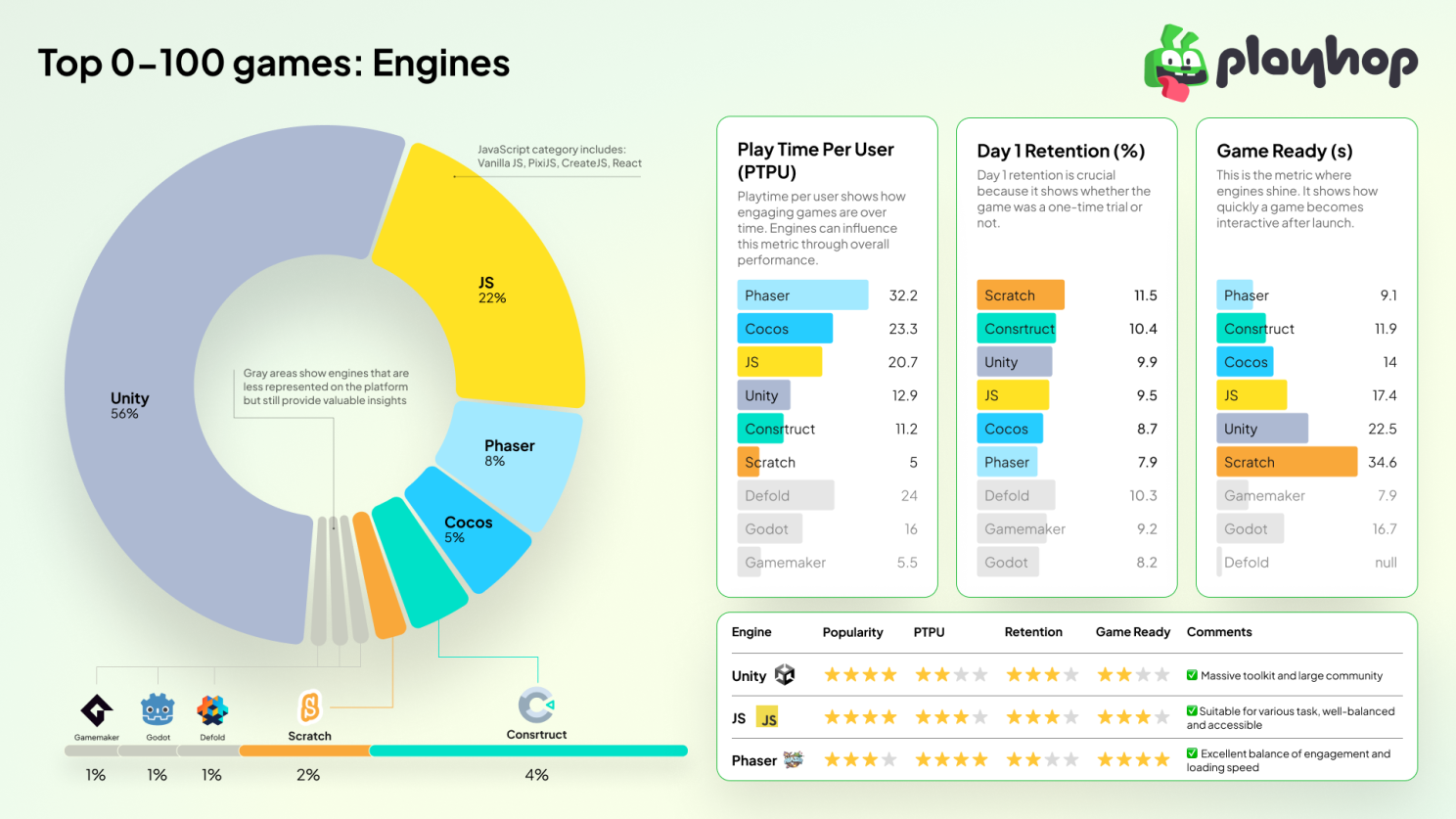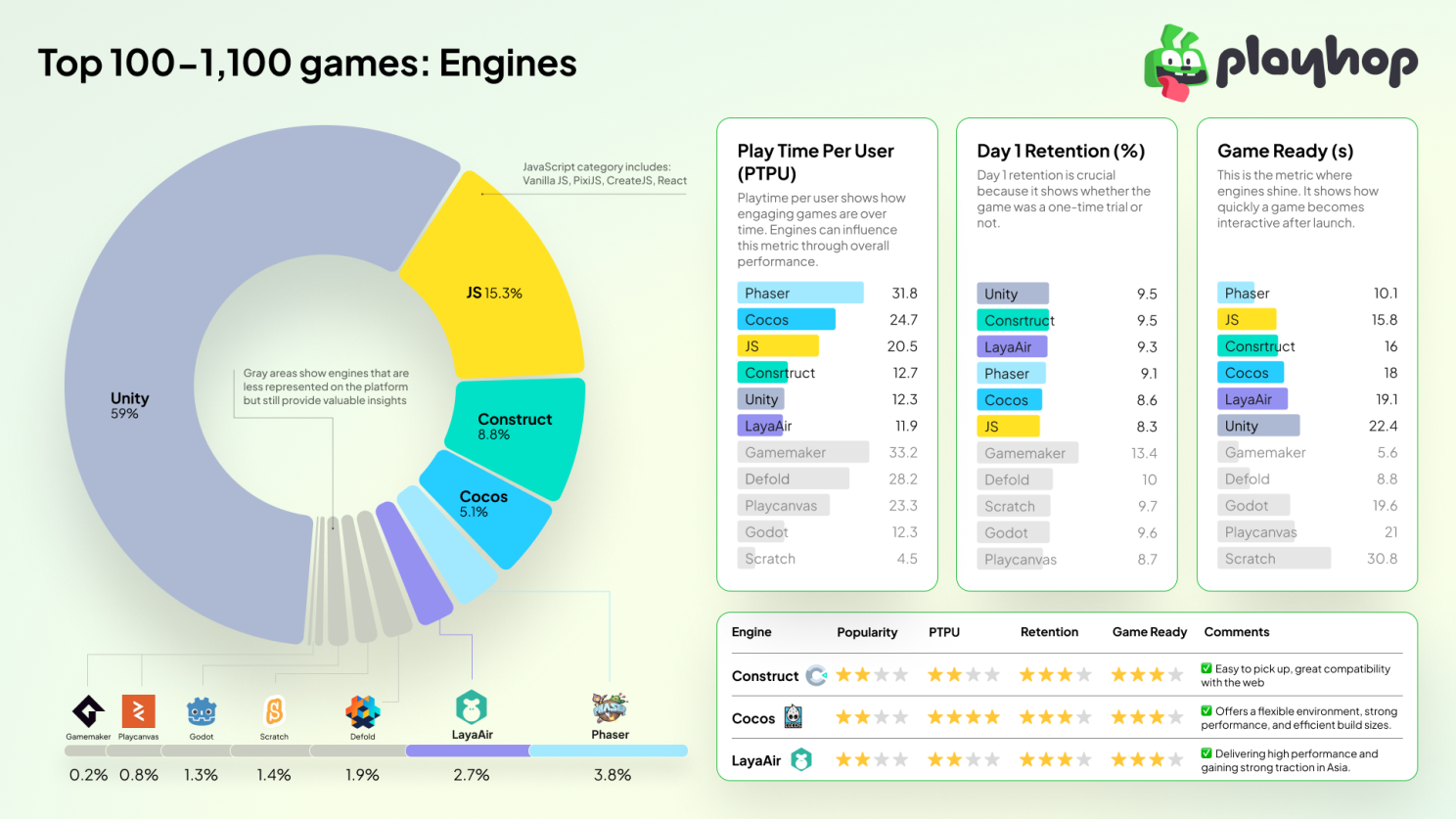Which Engines Power the Most Popular and Successful Web Games?
We selected the top 1,100 games based on how much time players spend on them.
A few words about us: Playhop is a web gaming platform featuring over 20,000 games built on various engines — from indie to titles by major studios.
Engines featured in the research:
UNITY. One of the most popular and versatile game engines in the world. Great for both 2D and 3D games, with strong cross-platform support. UNITY is widely used by both indie developers and large studios.
JS-based engines. Used to build games directly for the browser. Offers full control and flexibility, though often used with libraries or frameworks (like PHASER or Three.js). By the way, in that research, this category refers to a group of engines including Vanilla JS, PixiJS, CreateJS, and React.
PHASER. A fast and flexible 2D game framework for HTML5. Perfect for arcade-style games and great for developers who want full control of the game code. Works well in web browsers.
COCOS CREATOR. An open-source game development engine popular for mobile and web games. Offers strong 2D support and growing 3D capabilities. Widely used in Asia.
CONSTRUCT. A no-code/low-code engine designed for 2D games. Great for rapid prototyping and game development without needing deep programming knowledge. Exports easily to the web.
DEFOLD. A lightweight, performance-focused engine is ideal for mobile and web games. Easy to learn and efficient, with strong Lua scripting support and a collaborative editor.
GODOT. An open-source engine with its scripting language (GDScript). Great for both 2D and 3D games, with growing popularity. Has export options for the web, desktop, and mobile.
PLAYCANVAS. A powerful 3D engine built specifically for the web. Uses WebGL and runs directly in the browser. Great for visually rich, interactive web experiences.
LAYAAIR. A high-performance open-source engine is mainly popular in Asia. Supports 2D and 3D game development with strong optimization for mobile and web platforms.
SCRATCH. A beginner-friendly, visual programming environment developed by MIT. Ideal for learning game development and creating simple games through drag-and-drop blocks.
GAMEMAKER. A beginner-friendly engine that’s easy to use for 2D games. Uses its scripting language (GML) and supports exporting to multiple platforms, including HTML5.
Play Time per User, Retention, and Game Ready
Let’s first figure out what these metrics are.
Playtime per user — a key metric we looked at to understand how engaging games are over time.
Game ready — how quickly a game becomes interactive after launch. This includes asset loading and initial responsiveness. A shorter game-ready time means players get into the action faster, and that’s critical for web games.
Retention — while the engine itself doesn’t directly determine retention, it can influence load speed and initial experience, which domatter. We looked at retention (Day 1) — data that’s available to every developer via their game console.
We observed clear trends: some genres consistently perform better. For example, hypercasual, idle, and puzzle games are among the top performers. This reflects both user preference and what works best on web platforms.
JS-based and HTML5 engines often start quickly, which helps with early engagement.
Some engines trade speed for flexibility or features — a factor to consider depending on the game’s genre and audience.

The best of the top 0-100
In this section, we take a closer look at the 100 most popular games.
UNITY is leading — no surprise there. But the numbers are still impressive: 56 out of the top 100 games were built with it. JAVASCRIPT-based engines come in second with 22 games.
That means over 50% of the top 100 games are made with UNITY. We started planning this research a year ago — and since then, the number of UNITY-based games has doubled.
It’s also worth noting there are two UNITY versions in use. The newer version runs a bit faster.
Other engines also make a showing:
- Phaser — 8 games;
- Cocos — 5 games;
- Construct — 4 games;
- Scratch — 2 games;
- Godot, GameMaker i Defold — 1 game each.

The best of the top 100-1,100
In this section, we analyzed the most popular games, from number 100 to 1,100.
The overall picture in numbers remains more or less the same — though now we have more data on less popular, but still important, engines thanks to a larger game pool.
UNITY once again holds about 50% of the share. That speaks to its accessibility and versatility. While there are cases where other engines excel, in more than half of the games, UNITY is the obvious choice.
JAVASCRIPT-based engines powers 153 games. Other engines show the following results:
- Construct — 88 games;
- Cocos — 51 games;
- LayaAir — 27 games;
- Defold — 19 games;
- Scratch — 14 games;
- PlayCanvas — 5 games;
- GameMaker — 2 games.
Tips for developers — which engine to choose?
UNITY offers the widest audience reach and development accessibility, and it remains the most well-known and widely used engine.
Despite its challenges, most developers continue to choose UNITY — largely thanks to its strong community, a vast library of assets, and cross-platform support. While some optimization issues persist in certain areas, many see these as acceptable trade-offs for the flexibility and ecosystem UNITY provides.
That said, UNITY isn’t the only viable option — other engines can be excellent choices depending on your project’s goals. Ultimately, the right engine depends on the game specifics.
For example, PHASER offers a great balance between performance and engagement, while PLAYCANVAS excels in niche projects that prioritize high-quality interaction.
DEFOLD leads in load speed. LAYAAIR is still quite niche at this stage, but we see strong potential. GODOT is also worth serious consideration — this open-source engine is slowly but steadily gaining traction on the web.
Conclusions
UNITY has taken over the top 100 in just a couple of years — not long ago, the list was mostly dominated by JAVASCRIPT-based engines. They still remain very strong, which is why we see it as a solid starting point.
There are some undeniable advantages to UNITY: cross-platform support and a wide range of ready-made assets. UNITY is great for complex projects, but there are some issues to watch out for, like long loading times in certain cases and large build sizes.
UNITY has a strong ecosystem and is a universal engine that keeps evolving. However, that evolution also brings challenges.
Some downsides are even tied to the engine’s strengths — for example, cross-platform support often leads to larger build sizes. That’s why it’s important to start with clear goals and choose the engine based on the specific needs of your project, not in a vacuum.
Also, we want to point out that CONSTRUCT made it into the top 3 by number of games, and its load time is only slightly behind that of JS-based engines — likely just within the margin of error.
Overall, you can build a game with good retention on any engine — it all depends on the business model.
Despite this, there’s one important thing we can say for sure, regardless of your circumstances: the game’s loading time — which is crucial on the web — directly depends on the engine. DEFOLD, PHASER, and other engines based on JavaScript are among the fastest and best optimized for the web.
In the past, JS-based engines dominated the market with simpler games. But as this research shows, the web is getting complex, and more and more advanced projects are being built with Unity — a trend that will definitely continue.
Unity seems set to occupy this niche, since doing the same work in JS-based engines requires a huge amount of effort. So we can expect to see more and more sophisticated games on the web.
If you’re into gaming too and want to earn revenue with your current or future game on the web, check out this page.
The text was originally published on October 2, 2025 on LinkedIn.